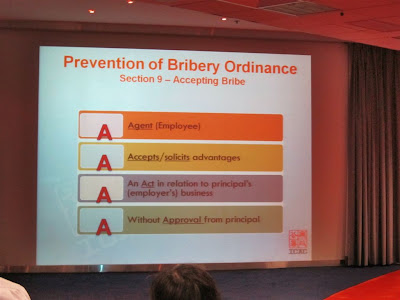In the beginning, Mr. Daniel Chan (the President of ISM-PRD and Global PCB Council Chairman of IBM China / Hong Kong Limited) gave an opening speech and introduced Dr. Marcus Chao.

We were honor to invite Dr. Marcus Chao as the speaker and he is the Founder & CEO of Lean China Enterprise (LEC), an affiliate of Lean Global Network. LEC is a non-profit organization aiming at promoting and educating lean practices in Great China.
Firstly, Dr. Chao explained what Lean Thinking was. There were four steps:
i) Focuse on customer needs (Customer Expectation)
ii) Define current value stream process and stabilize its current state (Understand Process)
iii) Go to Gemba to find problems and eliminate wastes (Find Gap and Wastes)
iv) Continuous improvement based on PDCA (Remove it)
Dr. Chao said creating a lean supply stream were to minimize waste and maximize value that was a key competitive advantage.
Dr. Chao introduced Lean Supply Stream was considered the following elements in every step.
Valuable – Henry Ford, Taiichi Ohno, Business Process Re-engineering
Capable – Total Quality Management, Six Sigma
Available – Total Productive Maintenance
Adequate – Theory of Constraints
Flexible – Toyota Production System
Three important concepts “Flow”, “Pull” and “Leveling” were mentioned by Dr. Chao.
Dr. Chao stated Toyota was the most advanced Lean Supply Stream that 300 suppliers from mostly first and second tier were cooperated for last 60 years (very stable group). Toyota used equity interlocked policy. For traditional companies relationship with supplier companies, they were short-term, price-based and minimum information exchange and visibility in the same value stream.
Then Dr. Chao introduced two critical enablers for customer companies to change relationships with suppliers below.
i) Cost management: Target pricing to achieve lowest total cost of ownership
ii) Supplier Development: Joint supply stream analysis to make sure every step is valuable, capable, available, adequate and flexible, as well as, linked and coordinated by flow, pull and leveling.
One of important practice called “Gemba walk” which should involve every company and department touching the supply stream to verify the “current state”, to envision ta short term “future state” and to develop a longer term “ideal state”.
Finally, Dr. Chao summarized the strategies to apply Lean Thinking in the following points:
· Build a reasonable size of supply base
· Quality first
· Cost management
· Supplier development
· Lean Logistics

During Q&A session, some participants questioned if reduced number of suppliers, they would communicate with each other to raise the price. Mr. Daniel Chan shared a hybrid concept to adopt part of Lean principle because of culture deviation. Another question was about Toyota recall case, Dr. Chao replied that it was because Toyota expanded to fast to control and their suppliers were not ready.
At the end, Dr. Chao introduced two books named “The Gold Mine I” and “The Gold Mine II” written by Freddy Ballé and Michael Ballé to us.

Mr. Daniel Chan represented ISM-PRD to present a souvenir to Dr. Marcus Chao.

I represented HKSQ to present a souvenir to Dr. Marcus Chao.

After the seminar, we had a dinner with Dr. Chao, ISM-PRD executive members and HKSQ ex-co members.

For more information:
Lean Enterprise China: www.leanchina.org/en_index.asp
ISM-PRD: www.ismprd.org
HKSQ: www.hksq.org
Dr. Chao introduced Lean Supply Stream was considered the following elements in every step.
Valuable – Henry Ford, Taiichi Ohno, Business Process Re-engineering
Capable – Total Quality Management, Six Sigma
Available – Total Productive Maintenance
Adequate – Theory of Constraints
Flexible – Toyota Production System
Three important concepts “Flow”, “Pull” and “Leveling” were mentioned by Dr. Chao.
Dr. Chao stated Toyota was the most advanced Lean Supply Stream that 300 suppliers from mostly first and second tier were cooperated for last 60 years (very stable group). Toyota used equity interlocked policy. For traditional companies relationship with supplier companies, they were short-term, price-based and minimum information exchange and visibility in the same value stream.
Then Dr. Chao introduced two critical enablers for customer companies to change relationships with suppliers below.
i) Cost management: Target pricing to achieve lowest total cost of ownership
ii) Supplier Development: Joint supply stream analysis to make sure every step is valuable, capable, available, adequate and flexible, as well as, linked and coordinated by flow, pull and leveling.
One of important practice called “Gemba walk” which should involve every company and department touching the supply stream to verify the “current state”, to envision ta short term “future state” and to develop a longer term “ideal state”.
Finally, Dr. Chao summarized the strategies to apply Lean Thinking in the following points:
· Build a reasonable size of supply base
· Quality first
· Cost management
· Supplier development
· Lean Logistics

During Q&A session, some participants questioned if reduced number of suppliers, they would communicate with each other to raise the price. Mr. Daniel Chan shared a hybrid concept to adopt part of Lean principle because of culture deviation. Another question was about Toyota recall case, Dr. Chao replied that it was because Toyota expanded to fast to control and their suppliers were not ready.
At the end, Dr. Chao introduced two books named “The Gold Mine I” and “The Gold Mine II” written by Freddy Ballé and Michael Ballé to us.

Mr. Daniel Chan represented ISM-PRD to present a souvenir to Dr. Marcus Chao.

I represented HKSQ to present a souvenir to Dr. Marcus Chao.

After the seminar, we had a dinner with Dr. Chao, ISM-PRD executive members and HKSQ ex-co members.

For more information:
Lean Enterprise China: www.leanchina.org/en_index.asp
ISM-PRD: www.ismprd.org
HKSQ: www.hksq.org













































